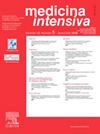Ictus en cuidados intensivos pediátricos
IF 3.1
4区 医学
Q2 CRITICAL CARE MEDICINE
引用次数: 0
Abstract
Objectives
To analyze the frequency, causes, risk factors, mortality and sequelae of stroke in children admitted to the pediatric intensive care unit (PICU).
Design
Single-center retrospective observational study based on a prospective database.
Setting
Pediatric intensive care unit.
Patients
Children between one month and eighteen years of age admitted to the PICU and diagnosed with stroke were included.
Main variables of interest
Epidemiological, clinical, diagnostic and treatment data, sequelae and mortality were recorded.
Interventions
None.
Results
46 patients were studied, of whom 29 (63%) had an ischemic stroke, 14 (30.4%) a hemorrhagic stroke, 1 (2.2%) venous sinus thrombosis and 2 (4.3%) mixed stroke. 11 patients (23.9%) had heart disease and 7 (15.2%) were treated with extracorporeal membrane oxygenation (ECMO) or ventricular assist. 8.6% of patients were treated with fibrinolysis or thrombectomy. 9 patients (19.6%) died. Patients with heart disease and those treated with ECMO had a higher mortality rate. 23 children, 62.1% of survivors, suffered sequelae at discharge. The most frequent sequelae were hemiparesis. Sequelae were significantly more frequent in patients who presented with motor symptoms (76.2%) (P < .001).
Conclusions
The frequency of ischemic stroke in pediatric patients is higher than that of hemorrhagic stroke. Pediatric patients who suffer a stroke have a high mortality rate and a high rate of sequelae. Patients with heart disease and those treated with ECMO are those who present stroke most frequently and have a higher mortality rate.
儿科重症监护中的Ictus
目的分析儿科重症监护病房(PICU)患儿脑卒中发生频率、原因、危险因素、死亡率及后遗症。设计基于前瞻性数据库的单中心回顾性观察研究。儿科重症监护室。患者:1个月至18岁的儿童被送入PICU并被诊断为中风。记录主要感兴趣的变量:流行病学、临床、诊疗资料、后遗症及死亡率。结果本组46例患者中,缺血性卒中29例(63%),出血性卒中14例(30.4%),静脉窦血栓形成1例(2.2%),混合性卒中2例(4.3%)。11例(23.9%)患者有心脏病,7例(15.2%)患者接受了体外膜氧合(ECMO)或心室辅助治疗。8.6%的患者接受纤溶或取栓治疗。死亡9例(19.6%)。心脏病患者和接受体外膜肺氧合治疗的患者死亡率更高。出院时有后遗症的患儿23例,占幸存者的62.1%。最常见的后遗症是偏瘫。出现运动症状的患者出现后遗症的频率更高(76.2%)(P <;措施)。结论儿童缺血性脑卒中发生率高于出血性脑卒中发生率。小儿中风患者的死亡率和后遗症率都很高。心脏病患者和接受体外膜肺氧合治疗的患者是中风最频繁和死亡率较高的人群。
本文章由计算机程序翻译,如有差异,请以英文原文为准。
求助全文
约1分钟内获得全文
求助全文
来源期刊

Medicina Intensiva
CRITICAL CARE MEDICINE-
CiteScore
2.70
自引率
20.00%
发文量
146
审稿时长
33 days
期刊介绍:
Medicina Intensiva is the journal of the Spanish Society of Intensive Care Medicine and Coronary Units (SEMICYUC) and of Pan American and Iberian Federation of Societies of Intensive and Critical Care Medicine. Medicina Intensiva has become the reference publication in Spanish in its field. The journal mainly publishes Original Articles, Reviews, Clinical Notes, Consensus Documents, Images, and other information relevant to the specialty. All works go through a rigorous selection process. The journal accepts submissions of articles in English and in Spanish languages. The journal follows the publication requirements of the International Committee of Medical Journal Editors (ICMJE) and the Committee on Publication Ethics (COPE).
 求助内容:
求助内容: 应助结果提醒方式:
应助结果提醒方式:


